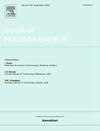Investigating constituent redistribution in U-Zr metallic fuels: A phase-field approach incorporating porosity and sodium infiltration
IF 2.3
3区 工程技术
Q1 NUCLEAR SCIENCE & TECHNOLOGY
引用次数: 0
Abstract
U-Zr metallic fuel, known for its superior thermal conductivity compared to fuel, is a promising candidate for advanced nuclear reactors. However, redistribution of constituents during operation affects the integrity of the fuel and phase stability, necessitating detailed investigation. In this study, a phase-field model was developed using the Multiphysics Object-Oriented Simulation Environment (MOOSE) to analyze the effects of porosity and sodium infiltration on redistribution behavior. A Baseline model incorporating a phase dependent porosity model was established, enabling comparative analyses. For instance, without considering porosity, our simulation resulted in an approximate 0.17 at% decrease in the central Zr concentration and a 36 K decrease in centerline temperature. Considering 50% sodium infiltration lead to a 0.7 at% lower central Zr concentration and an approximately 20 K decrease at centerline temperature. The findings demonstrate the importance of accurately modeling thermal conductivity to predict fuel behavior, providing a basis for optimizing U-Zr fuel performance in advanced reactor applications.
研究铀锆金属燃料中的成分再分布:结合孔隙度和钠渗透的相场方法
与UO2燃料相比,U-Zr金属燃料以其优越的导热性而闻名,是先进核反应堆的有希望的候选者。然而,在运行过程中,组分的再分配会影响燃料的完整性和相稳定性,因此需要进行详细的研究。在本研究中,利用多物理场面向对象仿真环境(MOOSE)建立相场模型,分析孔隙度和钠渗透对再分配行为的影响。建立了一个包含相相关孔隙度模型的基线模型,以便进行比较分析。例如,在不考虑孔隙度的情况下,我们的模拟结果表明,中心Zr浓度降低了约0.17 %,中心温度降低了36 K。考虑到50%的钠渗透导致中心Zr浓度降低0.7 %,中心温度降低约20 K。研究结果证明了准确建模导热系数对预测燃料行为的重要性,为优化先进反应堆中U-Zr燃料的性能提供了基础。
本文章由计算机程序翻译,如有差异,请以英文原文为准。
求助全文
约1分钟内获得全文
求助全文
来源期刊

Annals of Nuclear Energy
工程技术-核科学技术
CiteScore
4.30
自引率
21.10%
发文量
632
审稿时长
7.3 months
期刊介绍:
Annals of Nuclear Energy provides an international medium for the communication of original research, ideas and developments in all areas of the field of nuclear energy science and technology. Its scope embraces nuclear fuel reserves, fuel cycles and cost, materials, processing, system and component technology (fission only), design and optimization, direct conversion of nuclear energy sources, environmental control, reactor physics, heat transfer and fluid dynamics, structural analysis, fuel management, future developments, nuclear fuel and safety, nuclear aerosol, neutron physics, computer technology (both software and hardware), risk assessment, radioactive waste disposal and reactor thermal hydraulics. Papers submitted to Annals need to demonstrate a clear link to nuclear power generation/nuclear engineering. Papers which deal with pure nuclear physics, pure health physics, imaging, or attenuation and shielding properties of concretes and various geological materials are not within the scope of the journal. Also, papers that deal with policy or economics are not within the scope of the journal.
 求助内容:
求助内容: 应助结果提醒方式:
应助结果提醒方式:


